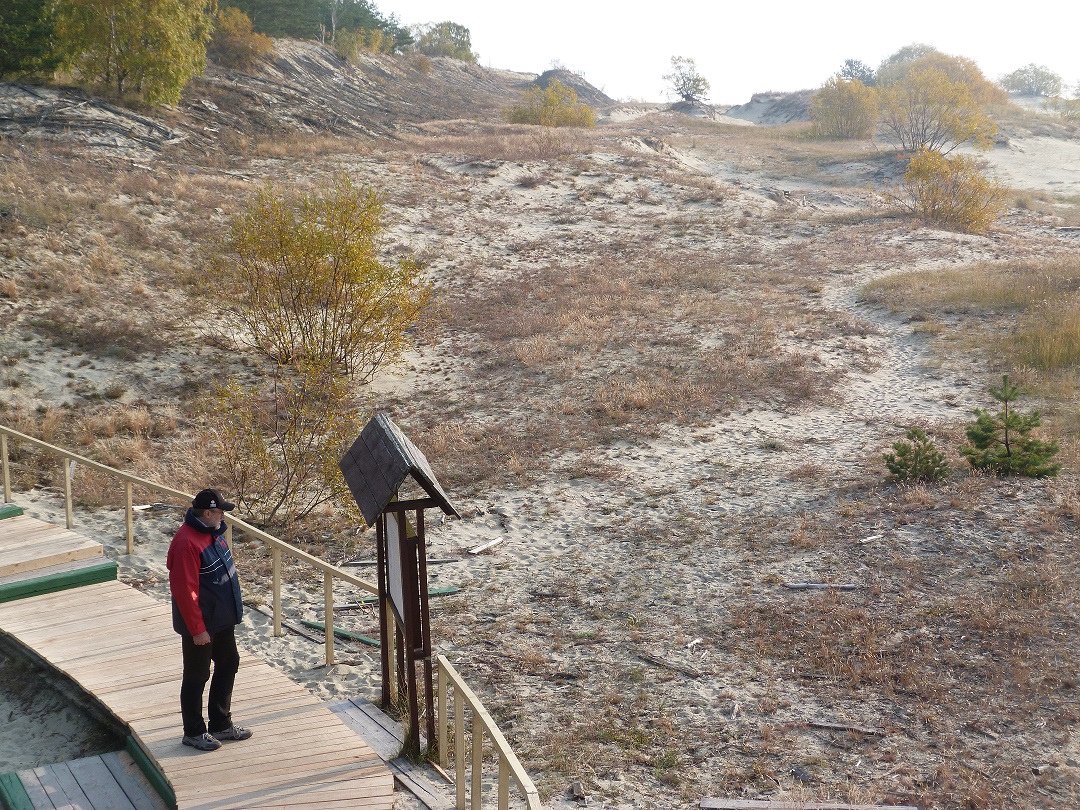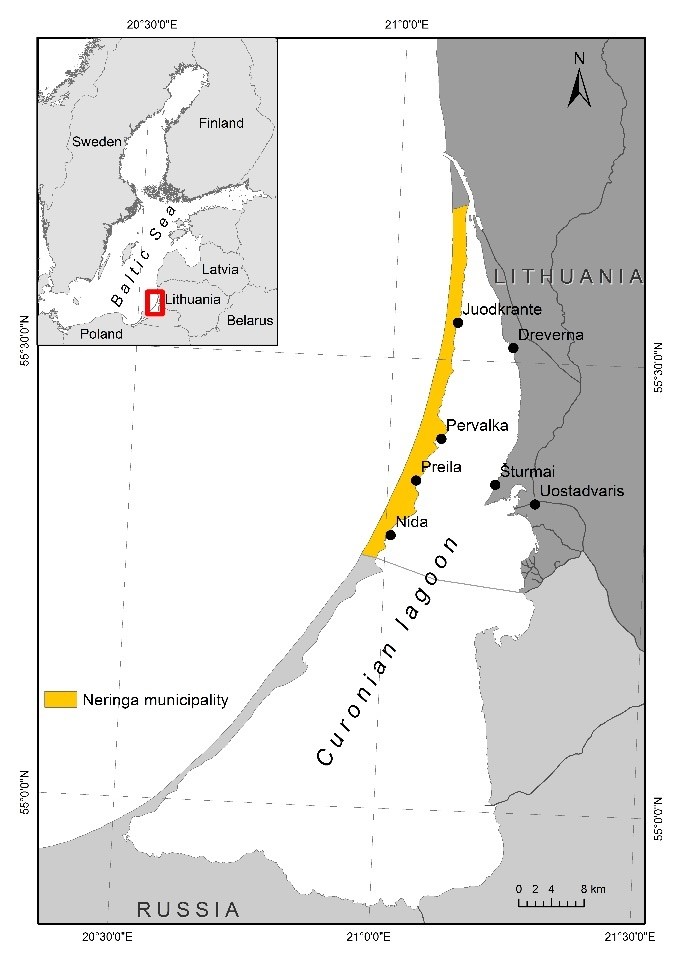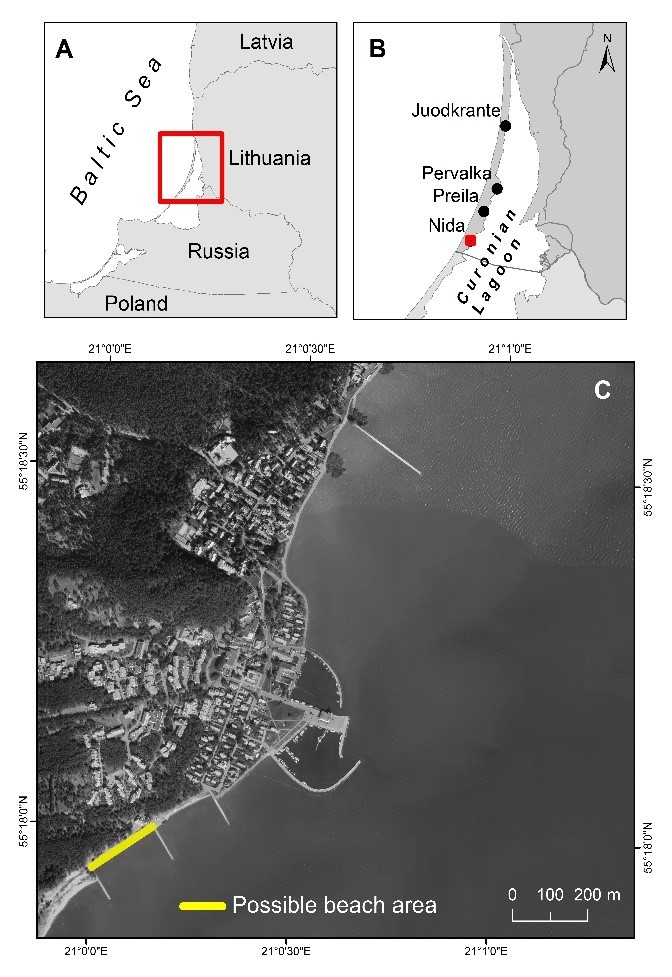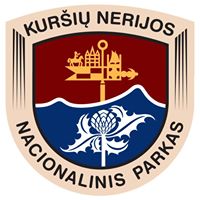Case Study
Application of research-based models for site management to extend the summer season on the Curonian Spit
Contact name
Aisté Jurkiene
Institution name
EUCC Baltic Office
Region & country
Lithuania
Summary
A radically new idea was proposed by the administration of Neringa to extend the summer season by opening a bathing beach on the Curonian Lagoon side of the spit. As the nearshore water in the shallow Curonian Lagoon warms up to 20°C already in May, opening of a new beach on the lagoon side could prolong the tourist season on the Curonian Spit. Hence it could positively affect all business sectors on the spit (accommodation, restaurants, etc.). The idea to open the beach on the lagoon coast as a major tourist destination, e.g., at Nida, could lead to a longer tourist season and better distribution of visitors throughout the year.


Location of the Curonian Spit, Neringa seaside resort
Photo source: BaltCoast project consortium of the EU BONUS Programme

Location of the Action 1 site at the Curonian Spit
Photo source: BaltCoast project consortium of the EU BONUS Programme
Background of the project
The Curonian Spit is one of the most popular domestic and inbound tourist destinations in Lithuania with ca. 2 million overnights in 2016. Tourism provides a major source of income for Neringa, but it is currently featured by extreme seasonality with roughly 72% of overnight stays taking place between the Midsummer holiday (June 24) and the Assumption holiday (August 15). It is mainly due to a very short bathing season in the Baltic Sea, which starts in the beginning of July, when the nearshore water temperature reaches 16 to 17°C – although not every year – becoming attractive for diehard seaside visitors to take short dips into the water, and lasts till the end of August, with nearshore water temperature almost never exceeding 20°C. The main negative impact of such a brief summer season is temporarily overexploited tourism infrastructure, and hence high prices in the peak tourist season resulting in an overall poor annual utilization of the infrastructure, prevalence of seasonal jobs, and social disbalances. Due to the short tourist season, the infrastructure of Neringa (wastewater treatment system, roads, ferries etc.), as well as the natural, fragile dune environment, and biodiversity become strongly affected by an almost tenfold increase in population of the municipality in July and August.
The main challenge for the sustainable development on the Curonian Spit is to extend the tourist season in Neringa, primarily, by its earlier start. The extension of the tourist season gives the possibility for the inhabitants and small-scale tourism businesses to have a more stable income and better paid jobs.
The issue of water quality, its suitability for bathing, and its aesthetic appeal is pivotal for opening an attractive bathing beach on the lagoon coast of the Curonian Spit.
Solution and actions taken
According to the EU Bathing Water Directive, the microbiological quality of the nearshore water in terms of E. coli is the main problem to open the lagoon beach for bathing, although most visitors, and potential bathers, primarily consider the aesthetic appeal in terms of algal and cyanobacteria ‘blooms’ when deciding upon the suitability of beaches for bathing.
Hence the need to take care that the beaches with a good water quality and high aesthetic appeal are chosen as possible new bathing sites on the lagoon coast of the Curonian Spit.
For that, we focus on so-called in-basin measures of research-based bathing water quality improvement, which is much smaller in scale than measures to improve the bathing water quality on the scale of the whole water body, e.g., the Curonian Lagoon, but could bring immediate result for local stakeholders, especially the ones interested in recreational values or habitat protection.
The use of ‘living barriers’ to semi-isolate one of the lagoon beaches on the Curonian Spit, located between two groynes. These barriers are formed by floating matts, or rafts that actively filter the nearshore water absorbing nutrients and facilitating degradation of E. coli. There are several commercial applications called ‘living’ or ‘active’ barriers (e.g. life rafts, BIOHAVEN® LIVING SHORELINE) aimed at both restoration and rehabilitation of coastal habitats and local enhancement of water quality by nutrient absorption and removal. It is not development of a totally new technology but rather an adaptation of the already existing and even commercialized one (mostly US and China) to environmental and social conditions of the Curonian Spit.
Other institutions or parties involved
- Administration of Curonian Spit National Park
- Neringa municipality
Results
There has been:
- a small scale local improvement of water quality (pilot installation) at a single location south of Nida, which is agreed by all key stakeholders,
- increased awareness of local stakeholders interested in water quality and tourism and innovations (SMEs) of the tested technological application. We aim to enhance the capacity of local communities to improve and protect their environment and to make use of sustainable tourism growth opportunities based on innovative green technologies and by identification of most promising scenarios for biodiversity conservation.
Groups with local stakeholders and market research have shown that:
- the new lagoon beach could be very attractive for families with small kids in the very beginning of the summer season (from the mid-May to the beginning of June), when the water quality in lagoon is still good enough (no algal ‘blooms’). The beach on the lagoon site is shallower and water conditions calmer compared to the beaches on the Baltic seaside.
- easy access to the lagoon beach by the visitors from the downtown Nida compared to the Baltic Sea beaches that are 3km off the downtown.
Challenges
No problems
Lessons learned
The highlighted good practice not only adapts, implements and demonstrates the approach itself, but also enhances the capacity of local and regional decision makers and managers to deal with forthcoming challenges for the environment related to the global climate change. These outcomes not only contribute to minor reduction of nutrient and E. coli concentrations in the lagoon waters, but also provide legal and economic basis for further developments in the area that could also benefit local innovation-focused SMEs.
Contact name
Aisté Jurkiene
Institution name
EUCC Baltic Office
Website(s)
